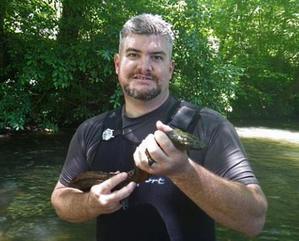 From the Georgia DNR Georgia Wild newsletter:
From the Georgia DNR Georgia Wild newsletter:
Eastern hellbenders have become a bit less elusive in north Georgia.
DNA analysis of water samples from 98 sites across the top of the state have provided Department of Natural Resources wildlife biologist Thomas Floyd a clearer picture of where the massive salamanders are still found in Georgia.
Floyd said the collaborative research with The Orianne Society (“Hellbenders in a bottle,” Sept. 30), part of a larger State Wildlife Grants project aimed at conserving Georgia amphibians and reptiles, “has given us a better idea of hellbender distribution and will allow us to concentrate our conservation efforts.”
That’s good for hellbenders and the scientists who study them (video)….
Hits and misses
The eDNA analysis confirmed the presence of hellbenders at six of 10 historical sites where they had not been seen in at least five years, 13 of 25 streams that had not been physically surveyed before and one site where hellbenders had been reported but researchers had been unable to find them in recent surveys. Also, although what looks like suitable habitat is found in streams that drain into the Chattahoochee, Conasauga, Etowah, Oostanaula and Savannah rivers, samples confirmed the presence of hellbenders only in the Tennessee drainage.
Some results were sobering.
Floyd, who works for DNR’s Nongame Conservation Section, said lab analysis showed that DNA amounts at historical sites that tested positive were minimal compared to levels found in streams with healthy populations. Also, eDNA tests did not detect hellbenders in any northwest Georgia stream, including those in the Tennessee basin where the species had been seen before.
“Hellbenders weren’t even detected from a stream stretch where a specimen was found in 2011, which indicates that – like several of the historical sites – the populations there are likely really small and it is uncertain as to whether they can persist into the future,” Floyd said.
He is disappointed by the lack of hits outside the Tennessee drainage, but says the research will lead to more efficient conservation. “We don’t have to expend time, effort and resources surveying, even in really good habitat, where we now know that hellbenders don’t occur.”
Read the rest of the article in Georgia Wild, here.
See a previous Georgia Wild article on hellbenders, here. It details the sampling technique. (And keep following the links back to trace the project to its beginnings.)
Photo: Biologist Thomas Floyd with a hellbender. Ga. DNR
